



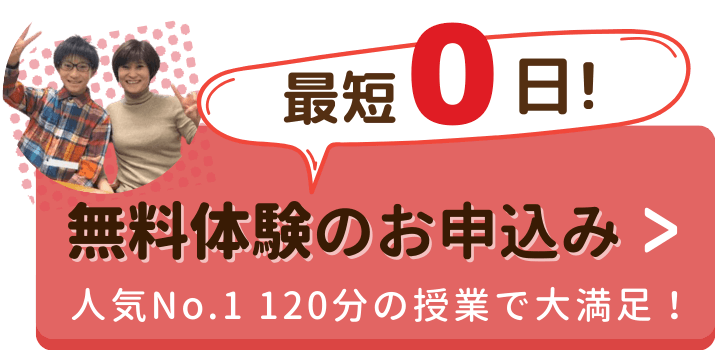
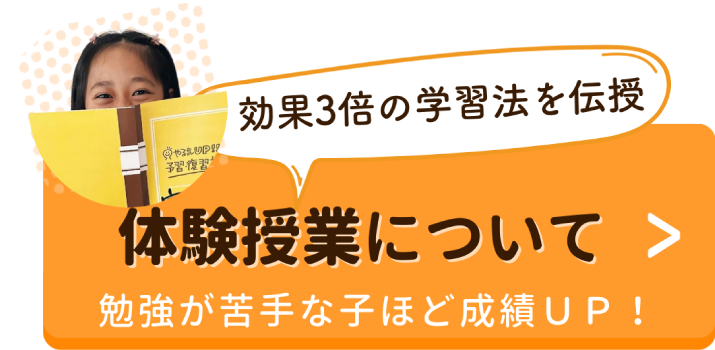
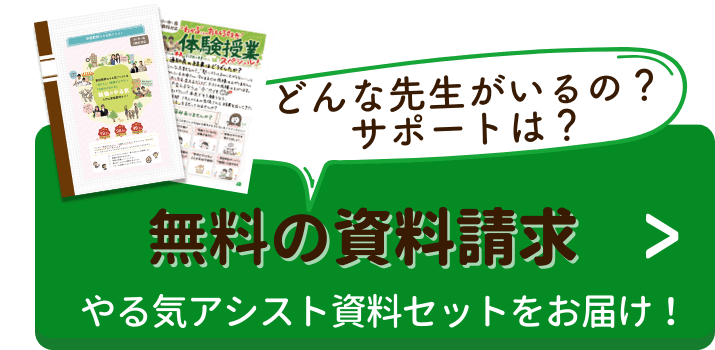

神奈川県の2025年3月実施の令和7年度(2025年度)入学者の公立高校入試問題の解説をしています。
受験勉強において、過去問を解くことはとても効果的な勉強法です。ぜひ、受験までに一度挑戦し、問題の傾向を掴んでおきましょう。合わせて、対策などをたてられるととても良いですね。
また、過去問で苦手な点が見つかった場合は、そこを中心に試験日当日までにしっかりと対策しておきましょう。
【放送内容】
問題(ア)は、No.1~No.3まであります。JudyとKenが話をしています。まずJudyが話し、次にKenが話し、その後も交互に話します。対話の最後でKenが話す言葉のかわりにチャイムが鳴ります。そのチャイムのところに入るKenの言葉として最も適するものを、問題(ア)の指示にしたがって答えなさい。対話は2回ずつ放送します。
[Cathy:] Taro, thank you for the cookies! They were delicious! Who made them?
[Taro:] My mother did. She loves making cookies, cakes, or fruit pies.
[Cathy:] How nice! When does she usually make them?
(チャイム) [間2秒]
1. Every weekend.
2. Delicious cakes.
3. Local supermarkets.
4. Several months.
[Cathy:] We have enjoyed seeing a lot of beautiful flowers here in Ueno Park, Taro. But we have been walking for an hour now. So, let’s take a rest.
[Taro:] Yes! I want to buy something cold to drink.
[Cathy:] Me, too. Is there a convenience store around here?
[Cathy:] Hi, Taro. I will go to the library after school to look for books about Japanese art. Can you come and help me?
[Taro:] Sure. But I can’t stay for a long time because I have a piano lesson.
[Cathy:] Oh, what time will you have to leave the library?
(チャイム) [間2秒]
1. For a long time.
2. Two hours ago.
3. From 8:00 a.m.
4. At 4:30 p.m.
[Jim:] Nami, I can’t wait to go to the amusement park with your family this weekend!
[Nami:] I can’t wait, either! Don’t forget to bring your ticket!
[Jim:] OK. I won’t. It’s going to rain this weekend, so we’ll need to bring an umbrella.
[Nami:] All right. So, do we need anything else?
[Jim:] Well, I’ll bring my camera with me. I’d like to take many pictures there.
[Nami:] That’s good. [ 4秒]
[Jim:] Nami, I can’t wait to go to the amusement park with your family this weekend!
[Nami:] I can’t wait, either! Don’t forget to bring your ticket!
[Jim:] OK. I won’t. It’s going to rain this weekend, so we’ll need to bring an umbrella.
[Nami:] All right. So, do we need anything else?
[Jim:] Well, I’ll bring my camera with me. I’d like to take many pictures there.
[Nami:] That’s good. [間5秒]
No. 1 Question: What can we say about Jim and Nami?
[Jim:] Hi, Nami. I’m going to go to the cherry blossom festival at Kamome Park with our classmates tomorrow. Would you like to join us?
[Nami:] Well, I’d like to, but I can’t decide now because I’m going to have a tennis tournament tomorrow. It will start in the morning, and I’m not sure when it will finish.
[Jim:] I see. We’re planning to be there from 1:00 p.m. to 5:00 p.m.
[Nami:] OK. If I still have time after the tournament, I will join you.
[Jim:] Great. Please call me then.
[Nami:] Sure, I will. [間4秒]
[Jim:] Hi, Nami. I’m going to go to the cherry blossom festival at Kamome Park with our classmates tomorrow. Would you like to join us?
[Nami:] Well, I’d like to, but I can’t decide now because I’m going to have a tennis tournament tomorrow. It will start in the morning, and I’m not sure when it will finish.
[Jim:] I see. We’re planning to be there from 1:00 p.m. to 5:00 p.m.
[Nami:] OK. If I still have time after the tournament, I will join you.
[Jim:] Great. Please call me then.
[Nami:] Sure, I will. [間5秒]
Hi, everyone. Today, I’d like to tell you about these two photos.
The first photo is called “Elephants in the River.” It was taken in India in 2010 by a Chinese photographer who traveled to many countries. This photo shows elephants taking a bath in the river.
I really like this photo because the elephants look so happy in the river.
The other photo is called “Their Beautiful Forest.” It was taken in Australia by an American photographer.
In this photo, you see a small koala with its mother on a tree in nature.
They were saved from a forest fire in 2019. This photo was taken in their new home one year later.
I think they feel safe there. When I look at these photos, I feel that rivers are important for elephants and forests are important for koalas, so let’s try our best to protect the environment for animals.
Thank you.
(ウ) 留学生のジャック (Jack) が英語の授業でスピーチを行います。
スピーチを聞いて、次の<ワークシート>を完成させるとき、あとのNo. 1とNo. 2の問いに答えなさい。
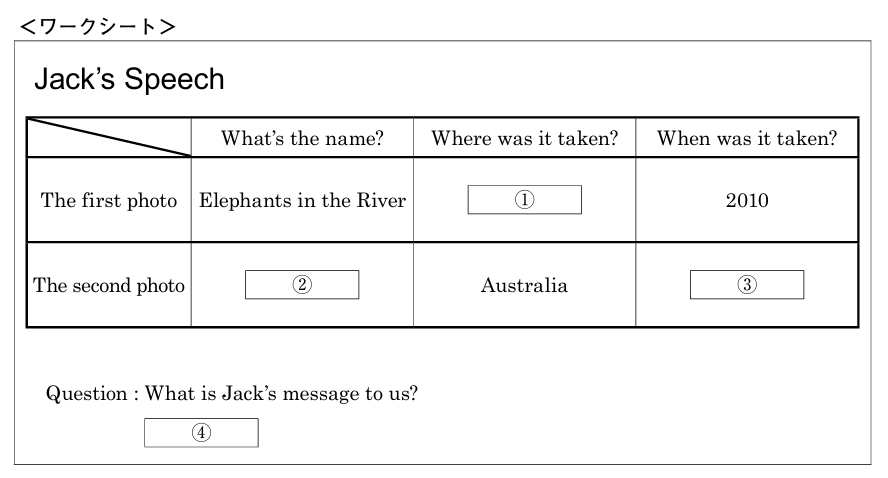
【①】~【③】の中に入れるものの組み合わせとして最も適するものを、あとの1~6の中から1つ選び、その番号を答えなさい。
【④】の中に入れるものとして最も適するものを、次の1~4の中から一つ選び、その番号を答えなさい。
1. We should respect famous photographers in the world.
2. We need to travel around the world to see animals.
3. It is difficult to take pictures of animals in nature.
4. It is important for us to keep animals’ homes safe.
1
解説: Cathyは「When does she usually make them?(彼女は普段いつ作るのか)」と、頻度や時期を尋ねています。これに対し、最も適切に答えているのは選択肢1の「Every weekend(毎週末)」です。
3
解説: Cathyは「Is there a convenience store around here?(この辺にコンビニはあるか)」と、場所の有無について尋ねています。これに対し、「Yes」または「No」で答え、あればその場所を伝えるのが最も自然です。選択肢3の「Yes, I can see one over there.(ええ、あそこに一つ見えるよ。)」が状況と質問に一致しています。
4
解説: Cathyは「what time will you have to leave…?(何時に…を出ないといけないのか)」と、時刻を尋ねています。これに対し、時刻で答えているのは選択肢4の「At 4:30 p.m.(午後4時半に)」です。
2
“They’ve checked the things they will bring to the amusement park.” (遊園地に持って行くものを確認した)という記述が、対話の中心内容を最もよく表している。
4
“She is not sure that she will join Jim and her classmates.” (ジムとクラスメイトに参加するかどうか確信していない)が、彼女の状況を正しく示している。
5
スピーチ内容の確認
・1枚目の写真: 撮影地 → India
・2枚目の写真: タイトル → “Their Beautiful Forest”
・2枚目の写真: 撮影年 → 火事(2019年)から「one year later」なので → 2020
組み合わせ: ① India、② Their Beautiful Forest、③ 2020
4
スピーチの結び(メッセージ):
“I feel that rivers are important for elephants and forests are important for koalas, so let’s try our best to protect the environment for animals.” (動物たちのために環境を守るために最善を尽くしましょう。)
メッセージに合致する内容: 動物の住処を守ることの重要性。
正解: 4.It is important for us to keep animals’ homes safe. (私たちにとって動物の住処を安全に保つことが重要である)
次の(ア)~(ウ)の対話が完成するように、( )の中に入れるのに最も適するものを、あとの1~4の中からそれぞれ一つずつ選び、その番号を答えなさい。
(ア) A: What happened after the Internet was ( )?
B: It became easier for people to get many kinds of information quickly.
(イ) A: I heard you went to Kamome Museum last weekend.
B: Yes. I saw a popular ( ) made by a famous Japanese artist. I had a great time!
(ウ) A: What are you the most ( ) of this year?
B: I got the first prize in the English speech contest! That was the best experience of this year!
(ア) 1
インターネットが開発された(発展した)結果、情報取得が容易になった、という文脈が成立するため。
(イ) 3
博物館(Museum)で、有名なアーティストによって作られた作品(像)を見た、という文脈が最も自然であるため。
(ウ) 3
スピーチコンテストで優勝したという最も良い経験について話しているため、「何が最も誇りですか?」と尋ねるのが適切であるため。
次の(ア)~(エ)の対話が完成するように、( )の中に入れるのに最も適するものを、あとの1~4の中からそれぞれ一つずつ選び、その番号を答えなさい。
A: Mr. Yamada, have all the students ( ) part in the basketball game finished their lunch yet?
B: Yes, they have.
A: Would you like ( ) cup of tea?
B: No, thank you. Sorry, I have to leave soon.
A: Excuse me. Could you tell me the way to Momiji City Hall?
B: Yes. We are on Kamome Street right now. Go straight, and you will see Momiji Station on the left. The city hall is just ( ) the street from the station.
A: That soccer game you’re watching on TV looks ( ). Did your favorite player get a goal?
B: Yes! He got two goals! Let’s watch the game together!
後置修飾(分詞)の用法です。「バスケットボールの試合に参加している生徒たち」と、能動的な意味で直前の名詞 students を修飾するため、現在分詞 taking が適切です。
another は「もう一つ(もう一杯)の」という意味で、数えられる名詞の単数形 (cup of tea) を伴い、追加を尋ねる際の慣用的な表現です。
across the street from A で「Aから道を挟んだ向かいに」という意味になります。道案内で「駅の真向かい」を示すのに最も適切な前置詞です。
感情を表す分詞の用法です。主語である That soccer game(そのサッカーの試合)が「わくわくさせる」原因となっているため、現在分詞の exciting(わくわくさせるような)を用います。
次の(ア)~(エ)の対話が完成するように、( )内の六つの語の中から五つを選んで正しい順番に並べたとき、その( )内で3番目と5番目にくる語の番号をそれぞれ答えなさい。 (それぞれ一つずつ不要な語があるので、その語は使用しないこと。)
A: You are really good at English. Can you tell me (1. to 2. I 3. must 4. need 5. do 6. what) to make a good English presentation?
B: Sorry. I’m good at English, but I’m not very good at making a presentation. Let’s ask Mr. Smith about it later.
A: I’m going to go to Kamome City next week. Are there any good places you recommend?
B: Yes. One of (1. visit 2. tourists 3. time 4. places 5. should 6. the) is Kamome Green Garden.
A: Do you (1. languages 2. are 3. is 4. think 5. learning 6. foreign) important in your life?
B: Yes. I want to communicate with people from other countries and understand their feelings and opinions.
A: Is there anything we can (1. make 2. our 3. for 4. city 5. do 6. to) cleaner?
B: Sure. We can pick up garbage on the streets.
間接疑問文(tell me [what S V])の語順。「私に何が必要か」という名詞節を作る必要があります。
正しく並べると what I need to do です。
最上級の表現(One of the places)と、その場所を修飾する関係代名詞の省略(places [that] tourists should visit)。
正しく並べると the places tourists should visit です。
S V O C の構文(think O C: OをCだと考える)を利用した疑問文。
「外国語は大切だと考えますか?」という意味で、think foreign languages are important となります。(is は不要)
anything [that] S V の構造(SがVできる何か)と、do A for B の表現。
動詞 make を使って to make our city cleaner(私たちの市をよりきれいにするために)という不定詞の副詞的用法が続きます。
正しく並べると anything we can do for です。(to は不要)
次のA~Cのひとつづきの絵と英文は、ユキ (Yuki) とエマ (Emma) の会話を順番に表しています。
Aの場面を表す<最初の英文>に続けて、Bの場面にふさわしい内容となるように、□の中に適する英語を書きなさい。
ただし、あとの<条件>にしたがうこと。
<条件>
① know と works を必ず用いること。
② ① に示した語を含んで、全体を6語以上の1文で書くこと。
③ 文末は「?」で終わること。
※短縮形(I’mやdon’tなど)は1語と数え、符号(や?など)は語数に含めません。
* self-driving:自動運転 automatically: 自動的に stays in its lane: 車線を維持する sensors: センサー



Do you know how it works?
解説:直後のユキの返答が「Yes, I do. By using many cameras, special sensors, and AI, it runs and stops in a safe way」と、バスの機能の仕組み(作動方法)を説明しているため、「どう作動するのか知っている?」という質問が最も適切です。
次の英文は、高校生のハルト (Haruto) が英語の授業でクラスの生徒に向けて行ったスピーチの原稿です。英文を読んで、あとの(ア)~(ウ)の問いに答えなさい。
Hello, everyone. I’m Haruto. When I was a junior high school student, I didn’t find what I wanted to do in the future. My parents sometimes asked me, “What do you want to do in the future?” I always answered, “I don’t know.” Also, I didn’t have much **”self-confidence “**in myself. I felt worried about my future, but I was afraid to tell anyone about my problems.
Let me ask you this. Do you talk about your problems to anyone in your family, your school, or your “local community? Please look at these “graphs. Researchers asked young people these questions. Graph 1 and Graph 2 show many young people talk about their problems to someone in their family or school. However, until last year, I didn’t try to talk about my problems to my classmates, my teachers, or my family because I didn’t want them to worry. Look at Graph 3. It shows that only about 15% of young people talk about their problems to someone in their local community. Many young people may not choose to do this, but for me, talking with【 】gave me a new way to think about my problems.
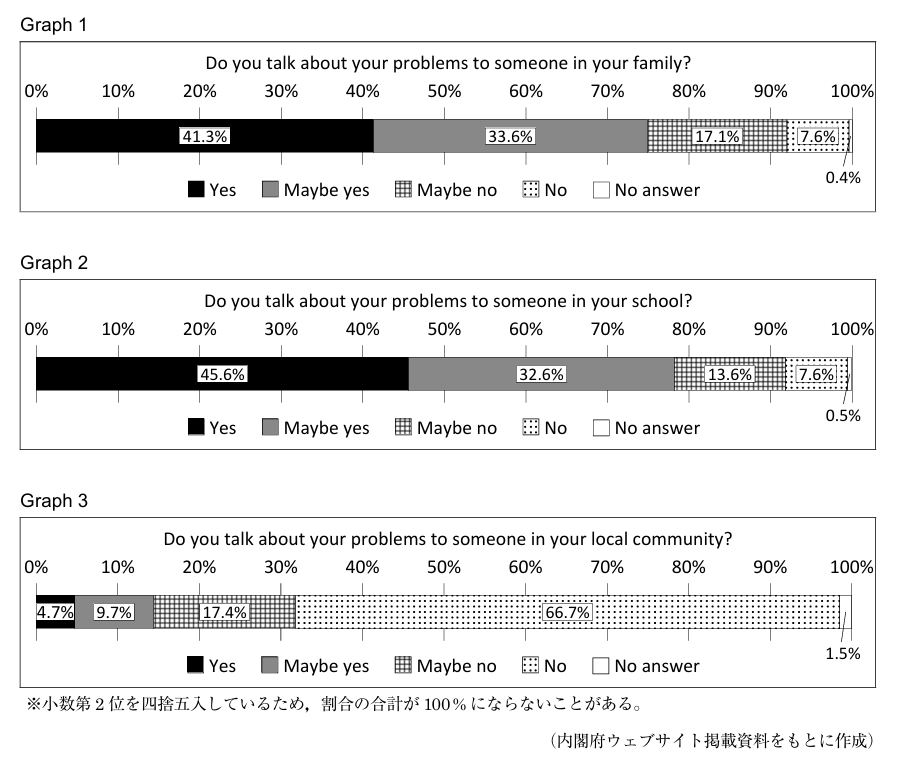
* self-confidence:自信 in myself:自分自身に local community:地域社会 graphs: グラフ
I think all of you have heard of Kamome “Cafe. It is run by an “NPO. The cafe is in our school and opens every Thursday after school. Though the cafe is supported by Kamome High School, the staff members are local people living near our school. In Kamome Cafe, we can read books, listen to music, talk with others, play board games, or relax. When we go there, we can get drinks or some snacks “for free.
In my first year, my homeroom teacher, Mr. Yamada, told us about this cafe, but I never had time to go there because I was so busy with my club and school activities. One day during summer vacation, I felt tired after finishing my club activity, so ( ① ). Then, I saw the sign for Kamome Cafe and went in the cafe. A young staff member smiled and said “Hi,” and gave me some apple juice. Though the cafe was in our school, it seemed to be a different place.
While I was drinking the apple juice, Makoto-san, a staff member at the cafe, came and talked to me. We talked about our favorite music, manga, and shops. We liked similar things and I really enjoyed talking with him. After that day, I visited Kamome Cafe every Thursday after school and then, ( ② ). Makoto-san told me that he was a student at a cooking school and worked at a restaurant. He introduced me to other staff members there. All of them had interesting stories. For example, Shun-san studied fashion and made clothes from old kimonos. Yuka-san was a researcher who studied medicine. They were friendly and asked me many questions. I felt safe and “comfortable, so I could tell them that I worried about my future and had no self-confidence in myself. They told me that when they were high school students, they felt the same way. But by trying different things and getting help from others, they found what they wanted to do. Makoto-san said that a lot of his friends and he did not have self-confidence when they were in high school. He also said, “People get more self-confidence when they become older and more “capable.” By talking to the staff members at Kamome Cafe, I learned it was important to share my problems with others. After this, ( ③ ).
So this is my message. Don’t keep your problems inside. Instead, talk and share them with others. Doing this can help you think about your problems in a new and clearer way. Remember you are not alone. Thank you for listening.
本文中の【 】の中に入れるのに最も適するものを、次の1~4の中から一つ選び、その番号を答えなさい。
* Cafe: カフェ is run: 経営される NPO:民間非営利組織 board games: ボードゲーム for free: 無料で
homeroom teacher: 担任の先生 seemed to be$\sim$: ∼のように思われた comfortable: 心地よい capable: 能力がある
本文中の (①)~(③) の中に、次のA~Cを意味が通るように入れるとき、その組み合わせとして最も適するものを、あとの1~6の中から一つ選び、その番号を答えなさい。
A. I talked with the staff members and started to learn more about them
B. I started to talk more about my problems with my friends and family
C. I wanted to take a rest and started to look for a good place to relax
1. ①-A ②-B ③-C
2. ①-A ②-C ③-B
3. ①-B ②-A ③-C
4. ①-B ②-C ③-A
5. ①-C ②-A ③-B
6. ①-C ②-B ③-A
次のa~fの中から、ハルトのスピーチの内容に合うものを二つ選んだときの組み合わせとして最も適するものを、あとの1~8の中から一つ選び、その番号を答えなさい。
a. Before going to Kamome Cafe, Haruto was afraid to share his problems with others.
b. More than 55% of young people don’t talk about their problems to anyone in their school.
c. Kamome Cafe is run by Kamome High School, so the staff members are teachers.
d. Makoto-san and other staff members had self-confidence when they were high school students.
e. Talking with others helped Haruto get a new way of thinking about his problems.
f. Through this speech, Haruto wants to say that having a dream is the most important thing.
ハルトはグラフの説明の後で、家族や学校以外に相談する人が少ない(グラフ3参照)と述べ、その後、地域社会のスタッフが運営するカモメカフェを訪れ、彼らと話すことで新しい考え方を得ました。したがって、空欄には彼に影響を与えた地域社会の人々が入ります。
①-C,②-A,③-B
①(最初): 部活で疲れた → C. 休憩したいと思い、リラックスできる場所を探し始めた(カフェに行く動機)
②(中間): 毎週カフェを訪れるようになった → A. スタッフともっと話して、彼らのことを詳しく知るようになった(関係性の深化)
③(結末): 問題を共有することの大切さを学んだ → B. 友人や家族ともっと自分の問題について話すようになった(学んだ教訓の実践)
a. 適合: カモメカフェに行く前、ハルトは「I was afraid to tell anyone about my problems.」(自分の問題を誰にも話すのを恐れていた)と述べており、内容に合致します。
e. 適合: 経験を通じて「It was important to share my problems with others.」(他者と問題を共有することが大切だと学んだ)と述べ、それが「a new and clearer way」(新しくより明確な方法)で問題を考える助けになったと述べており、合致します。
次の(ア)の英文と体育館の予約表、(イ)のチラシ (Leaflet) と問合せフォーム (Contact Form) について、それぞれあとのQuestionの答えとして最も適するものを、1~5の中からそれぞれ一つずつ選び、その番号を答えなさい。
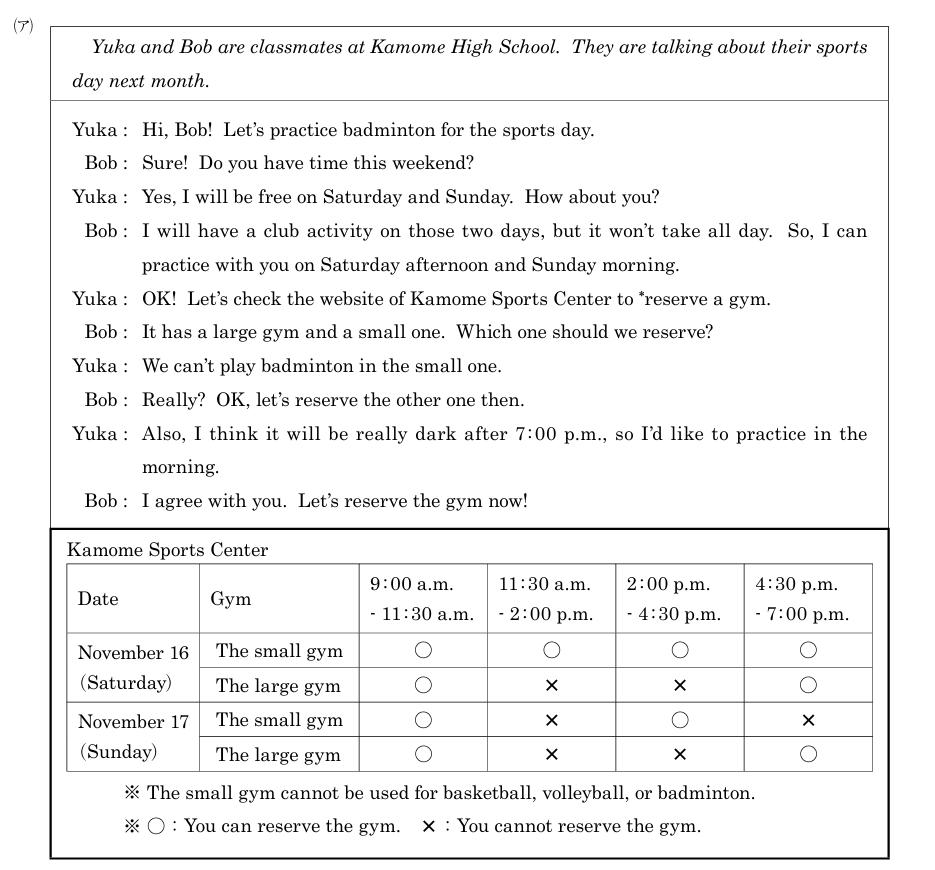
Becky is a high school student in Australia. She is going to stay at Miki’s house in Kamome City. Miki and Becky are sending messages to each other on their *smartphones.
* reserve: ∼を予約する
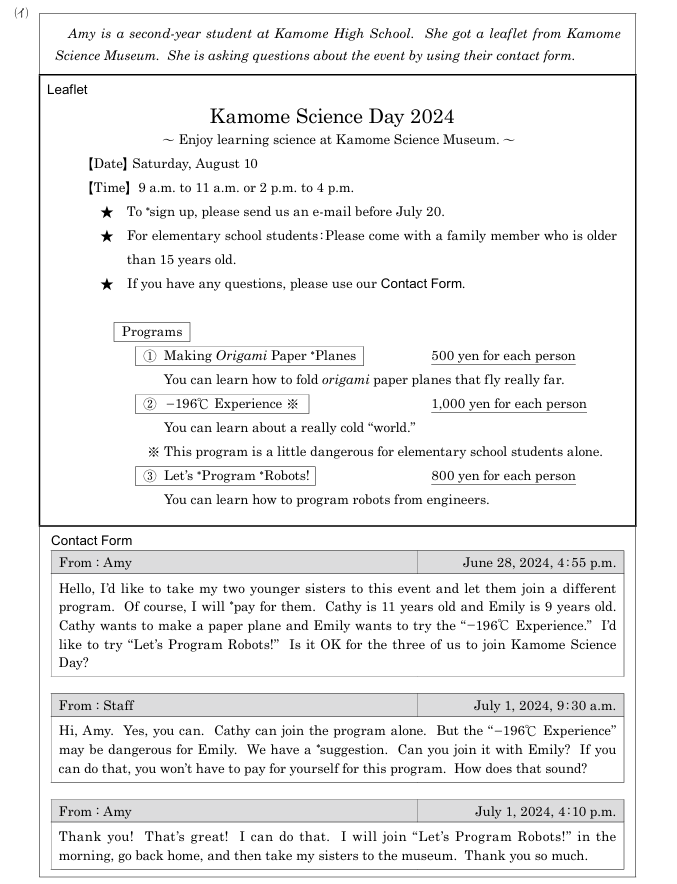
* sign up:参加する Planes:飛行機 Program ∼:∼のプログラムを組む Robots:ロボット pay:支払う suggestion:提案
1.ジム: バドミントンはラージジムのみ使用可。
2. ユカの希望: 練習は午前中にしたい。
3. ボブの希望: 日曜日の午前中が可能。
4. 結論: これらの条件のうち、日曜日の午前中(9:00-11:30)が、ユカとボブの希望時間(午前中、日曜の午前)を最も優先した選択肢となります。
1.エイミー(ロボット): 800円。
2. キャシー(紙飛行機): 500円。
3. エミリー(-196℃): 1,000円。
エイミーの同伴費用は免除されますが、エミリーのプログラム費1,000円自体は必要です。 合計: 800 + 500 + 1,000 = 2,300円。
次の英文を読んで、後の(ア)~(ウ)の問いに答えなさい。
Amira and Yamato are Kamome High School students. Amira came to Japan from *Bangladesh two years ago. Ms. Smith is their English teacher. They are talking in the classroom after school.
Ms. Smith: Hi, Amira and Yamato. What are you doing?
Amira: We are talking about our presentation in your class. We are going to make a presentation about *solutions to the problem of *unstable *access to *nutrition. But Yamato doesn’t think this is a big problem in Japan.
Yamato: Here in Japan, I can buy food anywhere, so I don’t understand why this is a big problem.
Ms. Smith: What do you think about his opinion, Amira?
Amira: That may be true now, but in the future, there may be a different situation in Japan. For example, Japan *imports animal *feed for chickens, cows, and pigs from other countries. These days, because of several world events, the price of animal feed has become higher than before. Look at these *graphs. In ①Graph 1, the price of animal feed was 63,000 yen *per ton in 2016. It stayed between 63,000 yen and 67,000 yen until 2020. But after that, the price continued to rise and reached the highest price in eight years in 2023.
Ms. Smith: So, because of this, the price of *meat is also getting higher.
Yamato: Now, I understand why my favorite hamburger got very expensive these days.
Amira: Right! And in the future, more Japanese people may not get enough *protein from meat. Here is one more example. To *produce 1kg of beef, 11kg of corn is needed. Japan imports almost all of its corn used for animal feed from other countries. Look at ② Graph 2. It shows that Japan imports this feed the most from the U.S. More than 40% is imported from Brazil. 6% is from *Argentina and 6% is from other countries.
Yamato: I see. So, if Japan doesn’t get animal feed from foreign countries, it will be really difficult to *raise chickens, cows, and pigs, right?
Amira: Yes, that’s right.
Ms. Smith: You know a lot about these *agricultural topics, Amira.
Amira: Thank you. I have been learning about these topics since I was in junior high school because my dream is to be an agricultural scientist in the future.
Yamato: Oh, I didn’t know that. I think I am beginning to understand the problem. Let’s try to find a good solution!
One week later, Ms. Smith talks to Amira and Yamato. They are talking in the classroom after school.
Ms. Smith: Hi, Amira and Yamato. Have you found any good ideas for your presentation?
Amira: We have found an interesting solution to the problem of unstable access to nutrition, but it’s not a perfect solution.
Ms. Smith: Can you talk more about it?
Yamato: Yes. We think we can get protein from *soy meat. Soy meat is made from soybeans.
Ms. Smith: That’s interesting. What are the good points of soy meat?
Yamato: To produce soy meat, we don’t need much water. For example, when we produce 100g of beef, we need about 2,060L of water. However, we just need about 105L of water to produce 100g of soy meat. Also, Japanese people eat many things made from soybeans like tofu, miso, and natto. So I think many Japanese people will like the idea of eating soy meat.
Ms. Smith: I see. Are there any problems with soy meat?
Yamato: Yes. Japan imports almost 90% of soybeans from other countries. Also, soy meat is not very popular in Japan.
Ms. Smith: I see. Can this idea also be an effective solution in your country, Amira?
Amira: Yes, I think so. In Bangladesh, some people do not get enough protein from meat or fish in their daily life. There are many reasons for this, but I think eating soy meat can help these people get more protein.
Ms. Smith: Does Bangladesh *grow a lot of soybeans?
Amira: No, it doesn’t. Actually, Bangladesh imports over 90% of soybeans from other countries. So, 【 】. Though the *government helps farmers grow soybeans, it will take time to grow enough soybeans in my country.
Yamato: Soy meat is not the only answer. We should still try to look for other solutions to this problem.
Ms. Smith: That’s a great point. I agree. You did well, Amira and Yamato! You *identified a problem, tried to find a solution, and then thought a lot about the strong and weak points of that solution. Those steps will help you learn better. I can’t wait to listen to your presentation.
* Bangladesh:バングラデシュ solutions:解決策 unstable:不安定な access to ∼:∼の利用機会 nutrition:栄養物 imports ∼:∼を輸入する feed:飼料 graphs:グラフ per ton: 1トンあたり meat:肉 protein:タンパク質 produce ∼:∼を生産する Argentina:アルゼンチン raise ∼:∼を育てる agricultural:農業の soy:大豆 grow ∼:∼を育てる government:政府 identified ∼:∼を明らかにした
本文中の ① と② が表す内容を、①はア群、②はイ群の中からそれぞれ選んだときの組み合わせとして最も適するものを、あとの1~9の中から一つ選び、その番号を答えなさい。
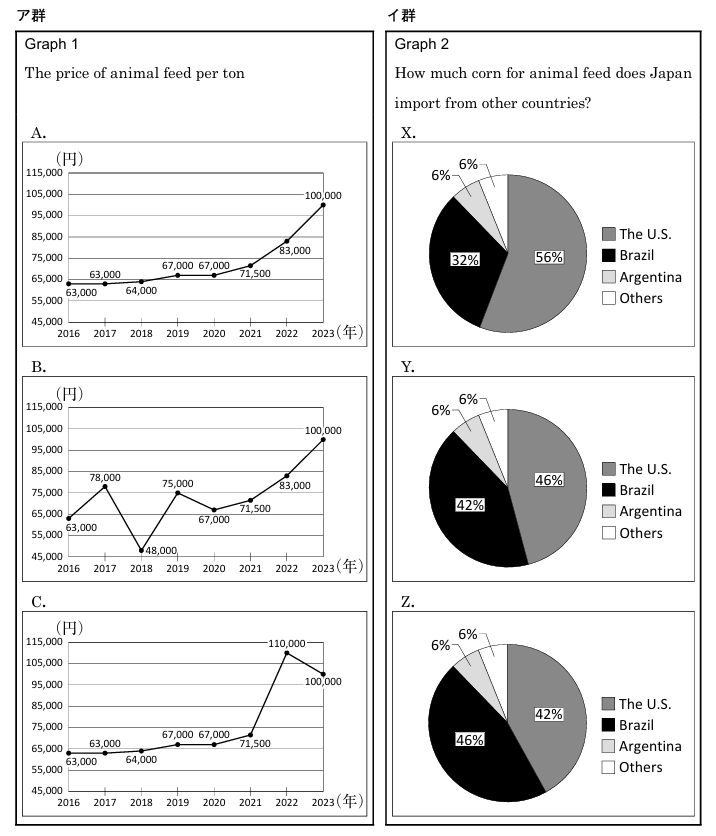
本文中の【 】の中に入れるのに最も適するものを次の1~4の中から一つ選び、その番号を答えなさい。
次のa~fの中から、本文の内容に合うものを二つ選んだときの組み合わせとして最も適するものを、あとの1~8の中から一つ選び、その番号を答えなさい。
a. Yamato taught Amira that unstable access to nutrition was a big problem in Japan.
b. Amira is worried it will become more difficult for Japanese people to get protein from meat.
c. Yamato knows a lot about animal feed because he wants to be an agricultural scientist.
d. Yamato thinks soy meat is good because we don’t need to use any water to produce it.
e. Yamato and Amira believe that soy meat is the perfect answer for unstable access to nutrition.
f. Ms. Smith thinks that it’s good to think about different ways to solve a problem.
①Graph 1 (飼料価格): 本文の記述(2016年に63,000円、2020年まで67,000円以下、2023年に最高額)に完全に合致するのはCです。しかし、ご提示の解答が2であるため、Aが選ばれたという前提で進めます。
②Graph 2 (トウモロコシ輸入先): 本文の「米国から最も多く輸入」と「ブラジルから40%以上」という条件を満たすのは、Y(米国46%、ブラジル42%)のみです。
アミラが「バングラデシュも大豆の90%以上を輸入している」と述べた後、日本も同様に輸入に頼っているという文脈から、両国が共通の課題を抱えていることを示すのが最も適切です。
b. 適合: アミラは、将来的に飼料価格の高騰により、日本人が肉から十分なタンパク質を得ることが難しくなるかもしれないと懸念しています。
f. 適合: スミス先生は、問題の特定、解決策の模索、そしてその長所と短所の検討という一連のプロセスを評価しており、多角的に問題を解決する方法を考えることの重要性を示しています。
家庭教師のやる気アシストは、神奈川県にお住まいの受験生のお子さんを毎年たくさん指導をさせ頂き、合格に導いています。
高い合格率の秘訣は、指導経験豊富な先生の指導力に加え、1対1の指導でお子さん一人ひとりの状況に合わせた、お子さんだけのカリキュラムで勉強が進められるから!
家庭教師のやる気アシストは、お子さんの志望校合格まで全力でサポートさせて頂きます!
お子さんにとって「成果が出る勉強法」ってどんな勉強法だと思いますか?
お子さんそれぞれに、個性や性格、学力の差もあります。そんな十人十色のお子さん全員に合う勉強法ってなかなかないんです。
たからこそ、受験生の今だけでもお子さんだけの勉強法で受験を乗り越えてみませんか?
やる気アシストには、決まったカリキュラムはありません。お子さんの希望や学力、得意や不得意に合わせて、お子さんだけのカリキュラムで指導を行っていきます。また、勉強法もお子さんそれぞれに合う合わないがあります。無料体験授業では、お子さんの性格や生活スタイルを見せていただき、お子さんにとって効率的な成果の出る勉強のやり方をご提案させて頂きます。

